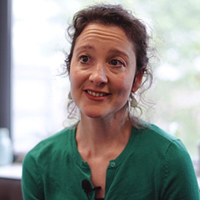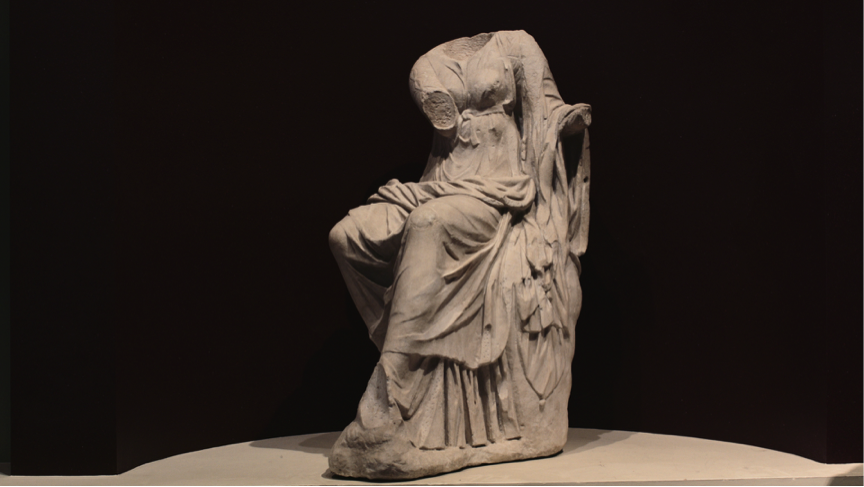A guest post by Marie-Louise Crawley
 Dr Marie-Louise Crawley is a choreographer and artist-researcher. In 2017 she spent six months as APGRD Artist in Residence, resulting in the creation of a site-specific solo durational dance work, Likely Terpsichore? (Fragments), performed at the Ashmolean Museum.
Dr Marie-Louise Crawley is a choreographer and artist-researcher. In 2017 she spent six months as APGRD Artist in Residence, resulting in the creation of a site-specific solo durational dance work, Likely Terpsichore? (Fragments), performed at the Ashmolean Museum.
A filmed version of Likely Terpsichore? (Fragments) can be viewed on the APGRD's YouTube channel >>

"What does it mean to be a fragmented body? To be scattered in a thousand pieces? Missing hand – missing elbow – missing foot – To be a body without a head; A statue without a face. To be faceless, To be nameless, To be almost. Upright, rooted to the spot, enclosed, resisting petrification. There is something about being fixed, being held, And trying to escape. Faceless, nameless, ancient women of the past… If I can unfix you, I can give you flesh."
- Likely Terpsichore? (Fragments) rehearsal notes, April 2018
Early in 2017, I was walking through the Ashmolean Museum’s gallery 21, the Randolph Greek and Roman Sculpture Gallery. I was on a site visit to the museum as I began a six-month artistic residency at the APGRD that gave rise to the eventual creation and performance of the solo durational dance work Likely Terpsichore? (Fragments) for - and in - this same museum. The durational dance work also formed the practice submission element of my doctoral thesis, undertaken at the Centre for Dance Research (C-DaRE), Coventry University. As I first walked through the gallery, I was drawn towards a marble sculpture of a seated woman. This statue was missing both its head and arms. The label next to it informed me that it was a Roman artefact (50-150CE) and that it was considered to be ‘likely Terpsichore, the muse of the dance.’ Somehow the sculpted woman was identifiable, despite missing her arms and the harp that would have been placed on her left side. Looking at her, I thought of how she was, in fact, defined by absence, by lack, by what is missing. Moreover, I could not even be sure that she is who we think she might be; she is ‘likely Terpsichore.’ What of the missing gaps in the story, the gaps between who she actually was and whom we think she might have been? Who was she really? Who is she?
 Right: Roman sculpture of ‘likely Terpsichore’, Randolph Gallery of Greek and Roman Sculpture, Ashmolean Museum of Art and Archaeology. Photograph: Brandon Kahn.
Right: Roman sculpture of ‘likely Terpsichore’, Randolph Gallery of Greek and Roman Sculpture, Ashmolean Museum of Art and Archaeology. Photograph: Brandon Kahn.
On that very first day in the museum, as I wandered the galleries, a desire grew within me, a desire to dance in that space; a desire for dance to flesh out partial stories, for dance to have the metaphorical potential to smash the glass enclosing the exhibited female remains of the Ashmolean’s Romano-Egyptian mummified bodies, or to become the mobile site of an embodied experience of an ancient Athenian bride painted on an Attic vase and ‘silenced’ for centuries, fixed in pigment. This would be a practice not so much about a museum collection, but about a re-collection (in both senses of the word). I wanted to ‘re-collect’ those female stories previously misrepresented or rendered partially invisible by history, and let those maimed, fragmented and silenced bodies speak for themselves through the dance. Likely Terpsichore? (Fragments) was performed in various iterations from March 2017-April 2018 as each of the four danced ‘fragments’ (‘Galatea’, Myrrha, Philomela and Medusa) developed, and the final durational dance work comprising all four solos was presented over two weeks in April 2018 during the museum’s usual opening hours (10am-5pm). Performed on three of the museum’s iconic glass balconies and walkways - designed by Rick Mather and a distinctive feature of the Ashmolean’s 2009 rebuild - the solos cycled continuously throughout the day and could be viewed multiple times and from multiple perspectives.

Marie-Louise Crawley performing in ‘Galatea’, Likely Terpsichore? (Fragments). Photograph: Brandon Kahn.
Drawing on four selected episodes from the Latin poem Metamorphoses, where women’s voices telling stories of sexual violence are appropriated even by Ovid, the dance practice in the museum built on the potential of principles from ancient Roman pantomime (namely that it was a solo, masked and narrative dance form) and ‘re-imagined’ the ancient sources in order to find new possibilities for twenty-first century performance. It sought to ask how choreography, like archaeology, allows us to excavate the body and the past. Is this a practice about remembering, or dismembering, an ancient form? What happens when this re/dismembering is put on display and exhibited in the museum? The practice itself places the dancer into the archaeological museum as an exhibit in order to subvert the idea of the female body as archival ‘object’ or artefact, historically subjected to the ‘gaze' of the male collector. How might the introduction of the female dancer into the museum allow buried or misappropriated female histories to surface and be ‘re-collected’? Through the work’s durational nature, I began to understand how dance performance in the museum might somehow allow for an alternative to a linear, diachronic and chronological narrative; the present-ness of the performing moment enabling a fragmentary, synchronic view rather than a linear ‘received’ version of events. In this, I was influenced in part by classical scholar Patricia Salzman-Mitchell’s work, who in her book A Web of Fantasies: Gaze, Image and Gender in Ovid’s Metamorphoses (2005) reads Ovid’s women in the Metamorphoses as witnesses who offer ‘glimpses’ of female narratives to be completed by the imaginations of female readers who are asked to ‘fill in the gaps.’ This appealed to my broader project of offering a glimpse of alternative female narratives of these heroines’ stories when performed through my dancing in the museum. Salzman-Mitchell’s idea of a female glimpse that is to be completed by the viewer also speaks to the ‘archaeological’ idea of a series of visual fragments that the viewer is called upon to reassemble. The durational practice in the museum sought to do exactly that: these danced fragments could be viewed from multiple angles, seen just once or several times. As such, each viewer only ever caught partial glimpses of the dance, fragments of a story that could be reassembled by the viewer multiple times and in myriad different ways. Through its fragmentary practices of remembering and dismembering, Likely Terpsichore? (Fragments) seeks to ‘resituate women on the inside of power’(as Mary Beard puts it in Women and Power: A Manifesto [2017]), but on their own terms, and, eventually, to enable an alternative means of viewing history in the museum.
Right: Marie-Louise Crawley in Myrrha, part of Likely Terpsichore? (Fragments). Photograph: Marchella Ward.
Finally, it is important to note here the video documentation of Likely Terpsichore? (Fragments) was recorded in the Ashmolean on a day on which the museum was closed to the general public and so while the video acts as a ‘memory’ of the dance practice as it was performed in the museum, it is not a memory of an actual public performance. Certain choices were made on that day by both myself and the video team doing the recording, such as the decision to keep to the idea of an ultra-objectification of the dancer watched through the camera lens, maintaining ‘a frame within the frame’ (the dancer framed by the glass framed by the camera lens), rather than a subversion of ultra-objectification that the live performance hoped to encourage in the viewer.
Find out more
- APGRD Artists in Residence
- Marie-Louise's residency was part of the APGRD's Performing Epic project.
- Centre for Dance Research (C-DaRE), Coventry University
- Marie-Louise Crawley, (2017),‘Likely Terpsichore? Dancing in the Museum of Ancient History and Archaeology,’ Performance Paradigm13: 66-79
- _______ (2018), ‘Epic Bodies: Filtering the Past and Embodying the Present – A Performer’s Perspective’ in F. Macintosh, J. McConnell, C. Kenward and S. Harrison (eds.), Epic Performances from the Middles Ages into the Twenty-First Century. Oxford, 163-180
- Alessandra Zanobi, an APGRD Short Guide to Ancient Pantomime and its Reception

